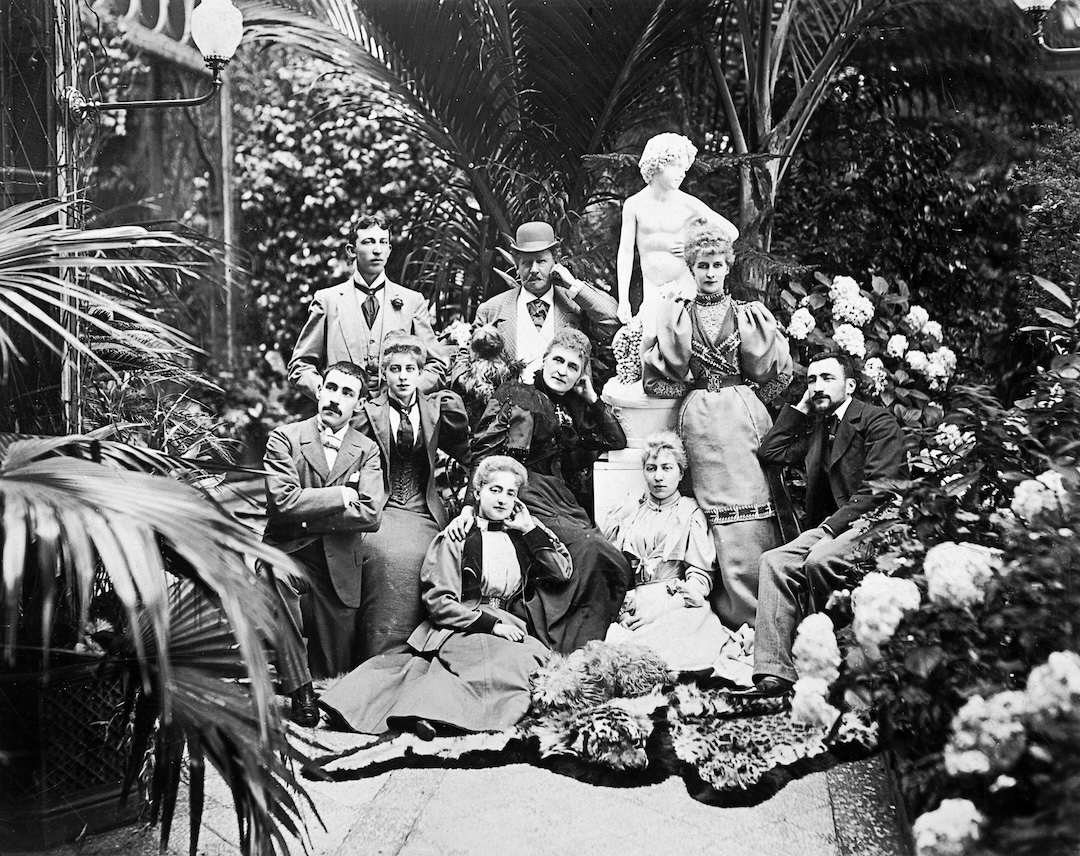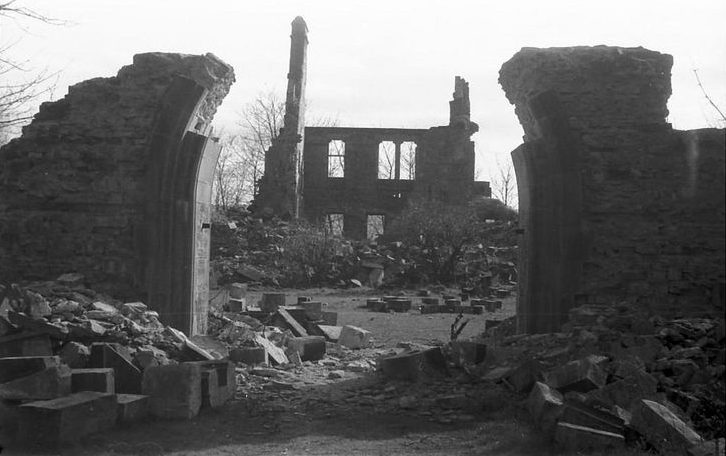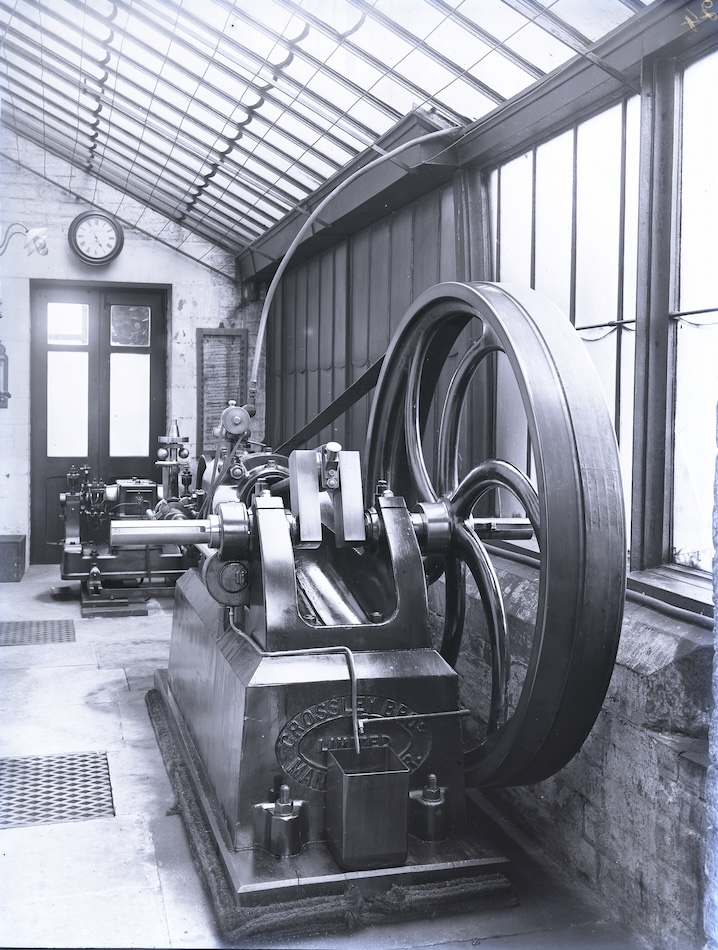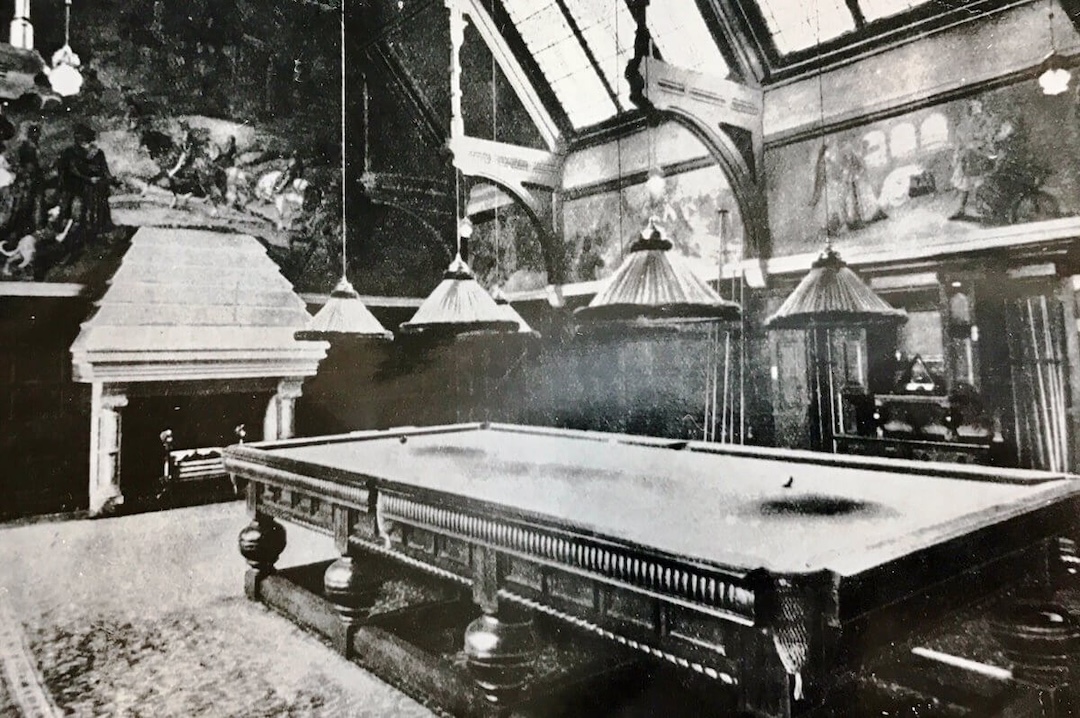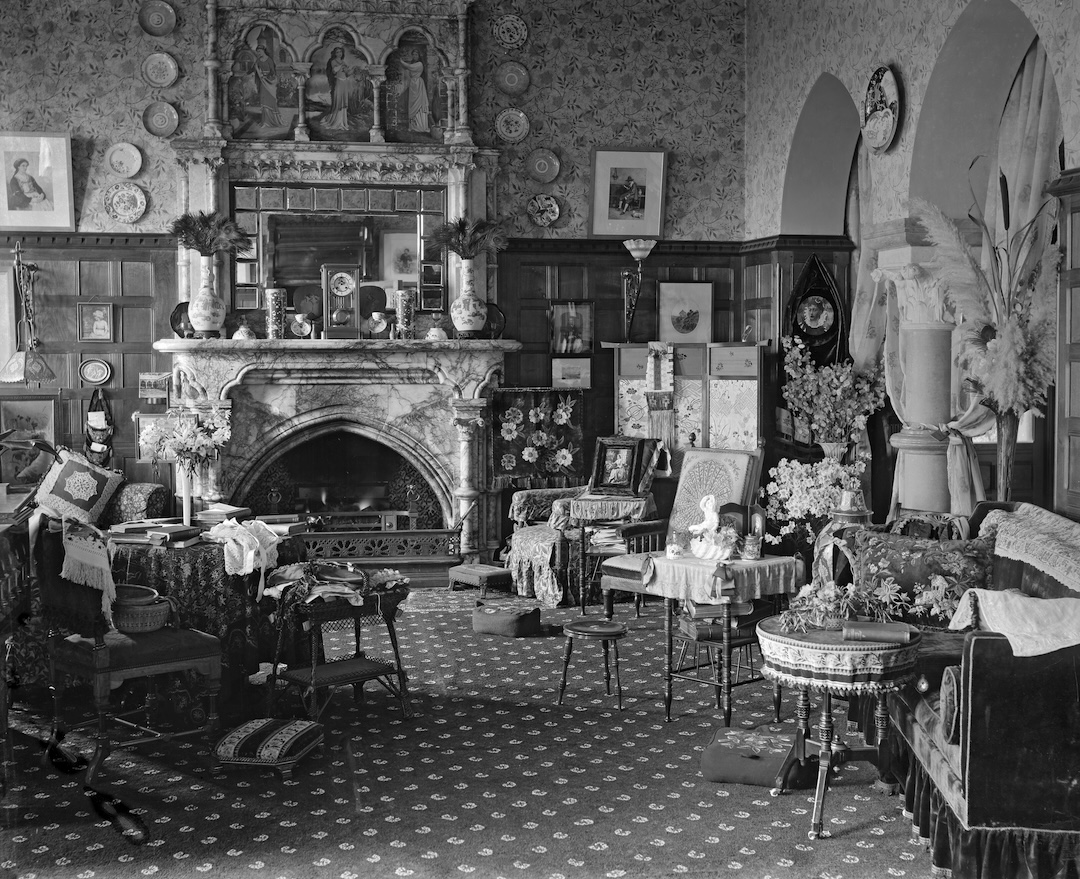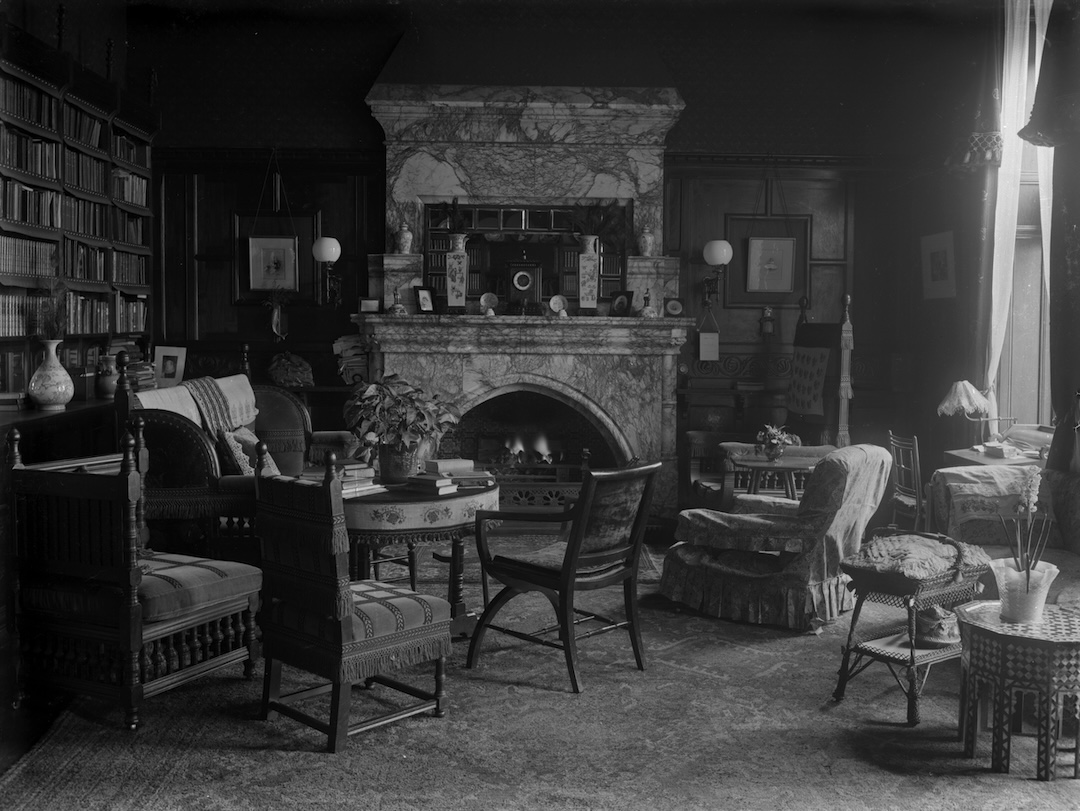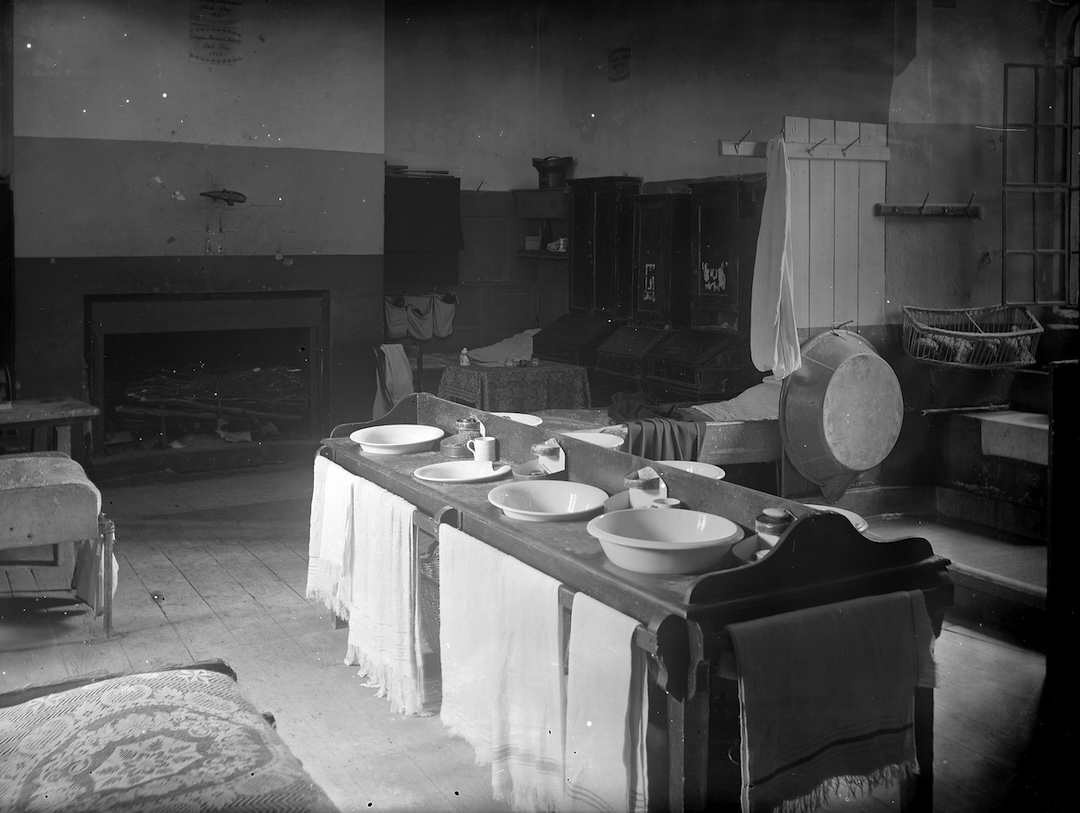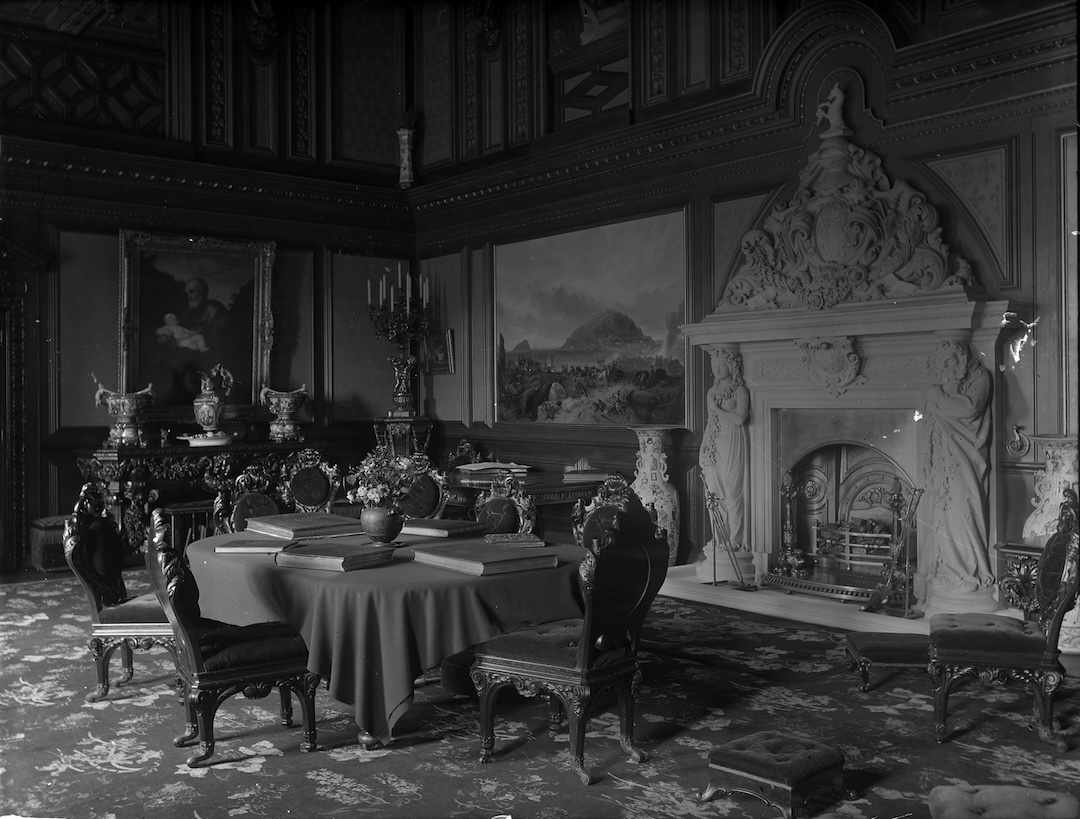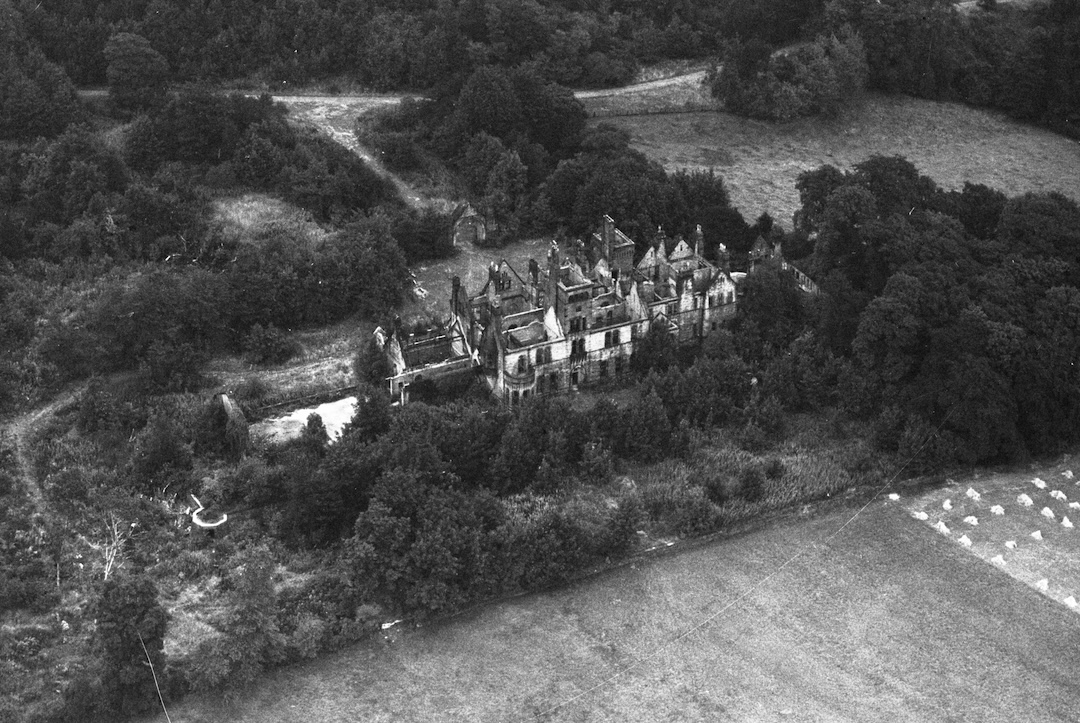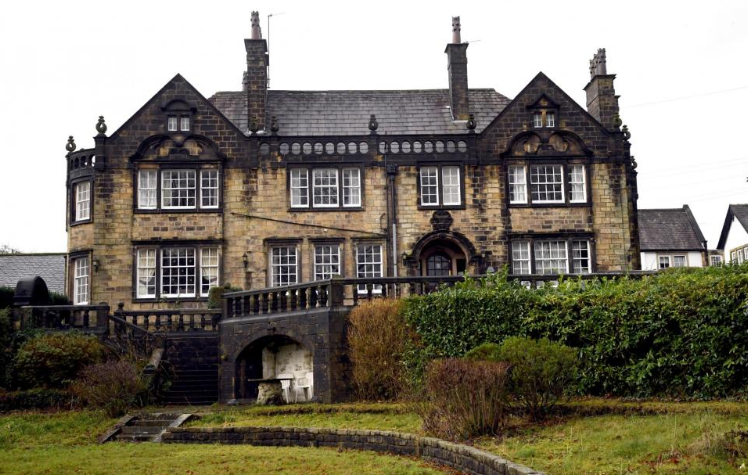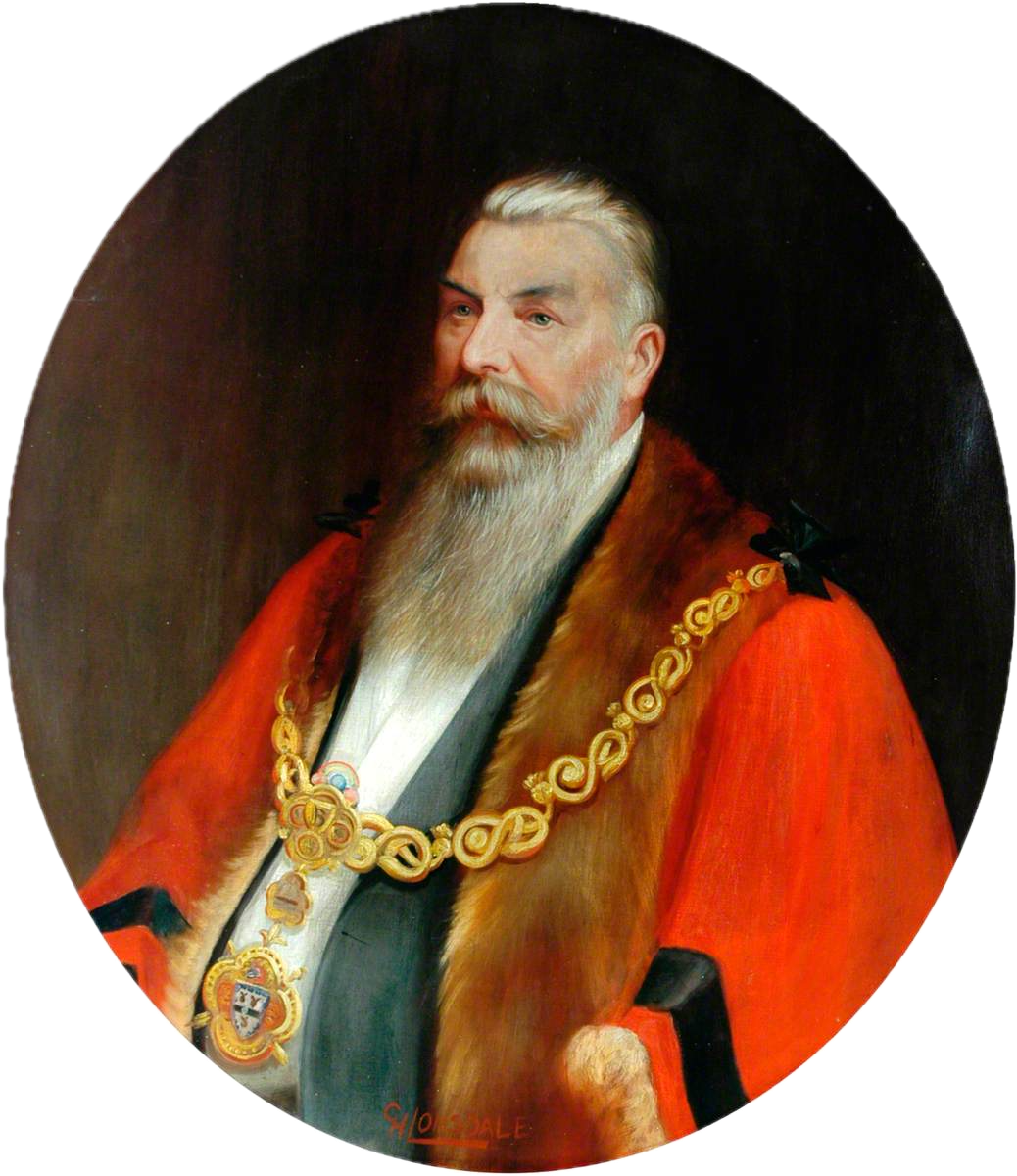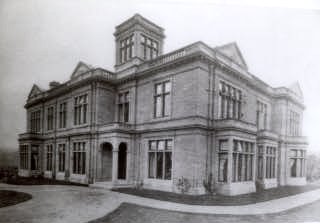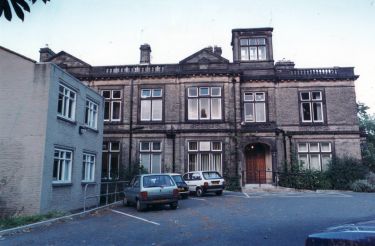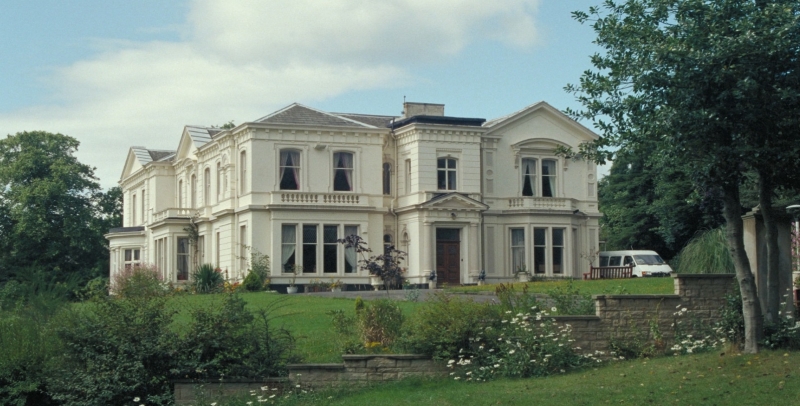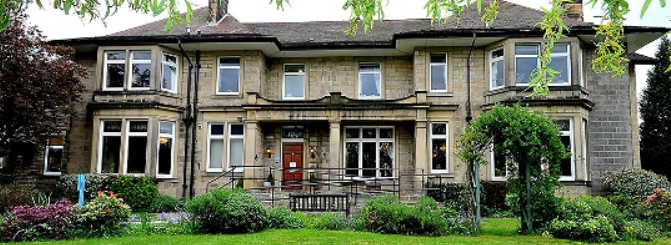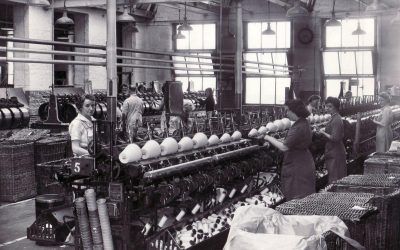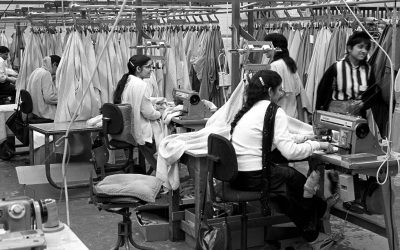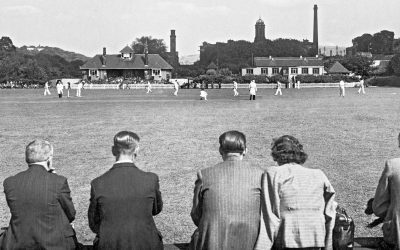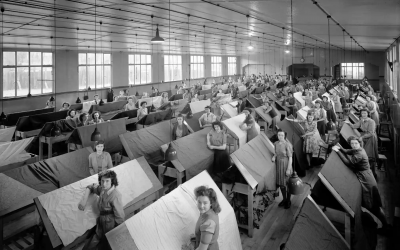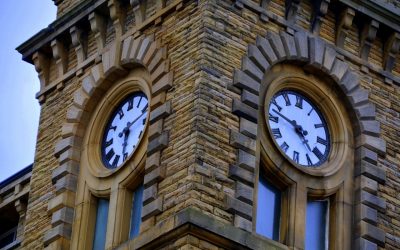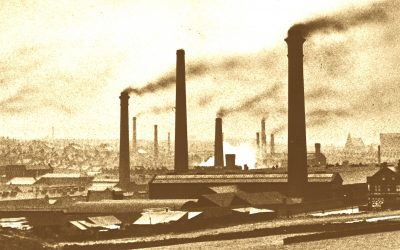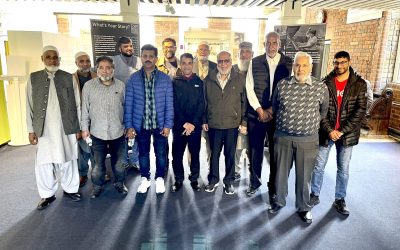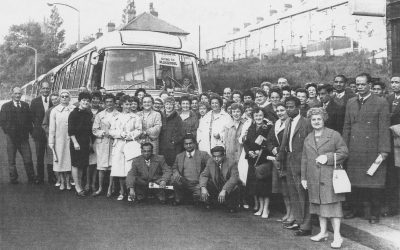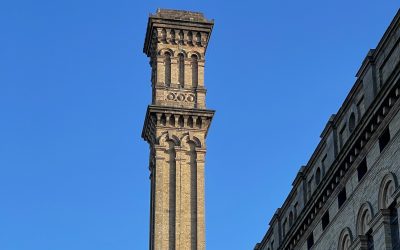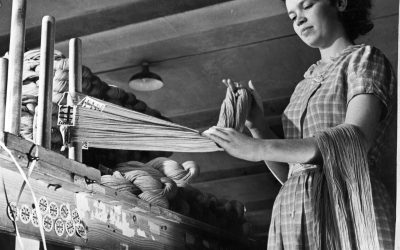Ghost Mansions
Photograph: Bradford Museums & Galleries | Cliffe Castle, Keighley, view from the Flower Garden with Signor Eugster de la Deheza, Ricardo Vines and Henry Isaac Butterfield (seated) c. 1890
I know that Robert Clough – he had a big mansion, and he donated a Christmas tree for the people of Keighley one year.
A Ghost in the Mill!
Roger Davy | Transcript
Well, I won’t be swayed on this at all. Particularly on a Friday night, when everybody else had gone home, I would walk through the mill, making sure everything was neat. Even though they were going to work, some of them, on Saturday mornings, I would always go through, just to make sure the place was secure, from my point of view. I knew it would be, we had Dennis Walker who did all the locking up. But I just liked to go through and make sure. And on two or three occasions, at least, I walked through the bottom shed and everything was quiet. And I switched on lights and switched them off again as I walked through. And I turned right from the bottom shed into the scouring. And I put the lights on in the scouring, and I walked between the two scouring bowls to the end where there was a conveyor belt which took the waste, the scoured waste, up a ramp and then dropped it into the hopper for the dryer. And the first occasion I sensed that I wasn’t on my own. And I don’t know why, I just felt that. And I turned round and I looked back down this the scouring, down the wash house. And I’m absolutely convinced I saw a figure standing at the end in a large overcoat with a hat on. I don’t know whether it was a trilby. I don’t think it was a top hat, but some sort of hat. And as soon as I looked this figure disappeared. And this didn’t happen once, it happened… maybe four times. Different times of the year. But normally when I was in the scouring on my own, with nobody else about. And I like to think it was probably my grandfather, my father’s father, who it was. I rather hope it was.
Father in Law a Mill Owner
Mark McGlinchey | Transcript
The only time I worked in a mill was in Wibsey, and it was my father-in-law’s mill. And the sad task was to dismantle all the machinery. And it was so sad, I mean, the last thing to go was what’s called a folding machine. He had decided to partly diversify into something else anyway. So when that finally happened, he had something else to fall back on, another business. But in terms of textiles, that was the last time that the Dobson family were involved in textiles in Bradford. His father had three mills. I just know that he must have made quite a good bit of money because they lived in a beautiful detached house in Hipperholme. His wife was chauffered around. And she used to get chauffeured down to Rackham’s in Bradford. It wasn’t called Rackham’s, it was called Brown Muff’s. And they used to know it was her, ‘cos they used to open the door specially. I mean they had things like a baby grand piano in one of the rooms of the house. And she had so many furs. It is another world of textile wealth.
Many big houses and mansions in Bradford were built between 1850 and 1930 with the money made from the textile mills. These impressive houses have different stories to tell about the families that lived in them and how they have been used since the mills closed.
Below are five examples of local mansions owned by former mill owners to learn about in more detail. Check out our Lost Mills Map to find even more!
A Ghost at Midgley's Mill
Christine Davenport | Transcript
Anyway, so you’ve got Midgley’s. Now, on a night time, it was quite eerie. There was a funny silence from about three o’clock. It’s like the dead. It’s like nothing. Not a bird, nothing. So you’d come out of the mill door, obviously, you opened up the mill when you’re going in and you’d hear all the clatter of everything, but when you went outside for that smoke, it was that really eerie silence. Midgely’s Mill though, there was a… I don’t know if it’s true or not… but apparently when they had the mill up on the back of Cavendish Street, (there’s new houses there now) … apparently they had a fire there. And a husband and his wife worked there. His wife apparently got caught in the fire. He went in looking for her. And apparently, they both perished in the fire. Allegedly. Now there’s two versions: One is that she survived, but he died in the fire looking for her. And the other one is that they both died in the fire. But when we went down to Midgley’s, down Dalton Lane, there used to be times when… I remember this big lap on a machine, and we started going down and we stopped. We couldn’t go any further. We got spooked. And there was just something…You couldn’t go any further. You ended up coming back. You could feel your hair standing up on…you know what I mean? Your neck would go. I don’t know whether it’s because we knew about that story, or whether or not there was something there. We don’t know. It used to be a workhouse at one time, did Dalton Mills.
Milner Field
Milner Field, Higher Coach Rd, Bingley BD16 4QR
Titus Salt built Salts Mill and Saltaire in the 19th Century and became one of the richest men in Yorkshire. In 1869, his son built Milner Field, a huge mansion overlooking Saltaire, at vast expense. Situated away from the noise and smoke of the mills, it was one of the most lavish buildings in the Aire Valley with a huge conservatory, specially commissioned furniture and a electricity generator in an outhouse!
On 19th November 1887, Titus Jnr was found unconscious in the billiard room and pronounced dead before a doctor could arrive. He was only 44 and the notorious reputation of Milner Field began…
Sir James Roberts bought Milner Field in 1903. His eldest son had recently died of pneumonia and a year later the youngest son tragically drowned. Eight years after that, the second son died of a “nervous illness” and the last surviving son was badly injured in WWI. The family was then scandalised when their married daughter’s lover was brutally murdered.
By 1923, Milner Field was bought by Ernest Gates. Weeks after moving in, his wife died and, within two years, Ernest had a “domestic accident” which led to septicemia and his death. In 1925, Arthur Hollins bought the property. Within a year, his wife died of pneumonia and three years later Arthur also died. He was the last Milner Field resident and by then the mansion had acquired a grisly reputation as being cursed and haunted.
The abandoned house fell into disrepair and ruin. By the 1950s anything of value had been sold or plundered and its stonework used to repair Salts Mill and Saltaire Village. What remained was demolished using dynamite until all that remained were piles of stone, stumps of walls, steps that led nowhere and the mosaic floor of the conservatory. But Milner Field’s gruesome reputation lives on and the site is visited by hundreds of walkers every year.
Laurel Mount
Woodville Road, Keighley, BD20 6JB
Ira Ickeringill (1836-1911) had Laurel Mount built in 1888, just after Cliffe Castle was built in Keighley. Ira became Mayor of Keighley from 1890-1893 but he had started life with very little.
Ira Ickeringill started work aged 8 in the mills in Keighley. In 1860, with his brother James, he set up a worsted spinning business in Legrams Mill in Bradford. In the early 20th century, Legrams Mill was the largest worsted spinner in the world with over 2,000 workers and 80,000 spindles that produced thousands of miles of yarn!
Ira, and his second wife Annie lived at Laurel Mount with their seven children and two servants. When their daughter, Ada, married in 1905, the wedding reception was held at the house. They also hosted lots of garden parties to raise funds for local charities and organisations.
The house also had two lodges which provided homes for a gardener, a coach driver and their families while the Ickeringill’s owned Laurel Mount and, after 1921, when it was owned by local politician and lathe manufacturer, Arthur Smith, who was also Mayor of Keighley in 1925-1926.
In the 1891 census, Fred Rothera lived in Laurel Mount Lodge with his wife and children. He was the gardener at Laurel Mount for over 30 years.
Frederick Preston lived in Laurel Mount Lodge Cottage for over 20 years. He was the driver for the Ickeringill family and in 1921 was a chauffeur for another Keighley mill owner. His son, Harold Preston, served in the RAF during World War One and in 1923 married Margaret Watkins, a nurse who worked at the war hospital in Victoria Park, Keighley.
Martha Conyers Smith, the only daughter of Arthur and Annie Smith, was invited to a garden party at Buckingham Palace in 1927. Garden parties were regularly held at the Laurel Mount by the Ickeringill family and the new owners, Arthur and Annie Smith, throughout the 1920s and early 1930s.
In 1926, Princess Mary who lived at Harewood House (King Charles III’s great aunt) came to lunch at Laurel Mount when she visited Keighley. During her visit she spoke to disabled children from the town, and was said to have “thoroughly enjoyed” her visit. Sadly Annie Smith died suddenly in 1933. Arthur Smith remained at Laurel Mount where he died in 1943.
In 1944, Laurel Mount and both of the lodges were put up for sale. Laurel Mount was purchased by Ellis Wharton, a local master builder. His wife, Maude, and her unmarried sister, Bertha Cooke, also lived at the house. Sadly Bertha died in 1946 and Maude and Ellis died in 1953.
Laurel Mount then had a number of owners before it opened as a nursing home in 1983. Different companies have run Laurel Mount and it closed suddenly in 2022 as inspectors rated it as “inadequate”.
In 1986, Laurel Mount became a Grade II listed building, so whatever the future may hold for Laurel Mount the house will remain part of Keighley’s heritage.
Tong Park Hall
Hollin Head, Baildon BD17 7NY
Tong Park Hall and Lodge were built by the Denbys of Wm Denby & Sons, Tong Park, in the late 1800s. The house at 2 Tong Park was given the name Woodlands.
In 1930, Tong Park Hall was home to Sarah Christiana, Alice, Henry and Richard Denby with Lily Dunning, Annie Long and Janie Long. In 1940, Tong Park Hall had Richard, Alice and Henry Denby with Jeanie Long and Kathleen Coning. And at 2 Woodlands Joseph Denby, Saraj Willis and Annie Cobb.
In the 1950s, the building was acquired by Bradford Council and it became a children’s institution, a children’s home, and then from around 1962, a remand home run for some, if not all of its time, by West Riding of Yorkshire County Council, until it closed in 1995. There was a planning application raised in 1996 for alterations to youth accommodation comprising the kitchen and teaching block, plus hardstanding for access to the rear of the building.
In 2001, David Wilson Homes submitted a planning application for the construction of 29 dwellings with associated garages on the site of the Hall, causing its demolition. Hollin Head was then made longer and Hallside Close and Broadacre Way constructed and houses sold from 2002. 6 Hallside Close was sold in Oct 2002 for £395,000.
Mum Worked at Denby's Tong Park Hall
Joe Sheeran | Transcript
She worked for Denby’s, Tong Park Hall, which is just above the factory, Denby Rain, as it was called, the higher ground above the factory in its own grounds. The main entrance, which was two gates, a bit like Buckingham Palace, it was huge, it was a huge mansion. And I first encountered it when I was six, seven years of age, towards the back end of the war, I seem to remember. My mother worked there, she worked there daily, she went every day. But I had an aunt who lived in, and she was a housemaid. And so I was allowed to really wander around. They were very tolerant, I didn’t understand how tolerant they were. There was two brothers, sorry three brothers, and a sister. There was Mr Harry, who was the oldest, big heavy white man. Mr Richard, who was much slimmer than him and younger. Mr. John, who was the youngest. And then Miss Alice, who was the sister. And she really controlled the house, which as I say, was a very, very big house. I liked the way it was laid out, which was in a square, and the main entrance was at the front of the square. And the servants’ entrance was towards the back of the house. It was a huge, huge house. They went eventually. I think Harry died, I think Richard wasn’t far after him, or was it Richard died first and then Harry, I’m not sure which. Anyway, it was too big a house for a sister and one brother, so they left it and it was taken over by the educational authority. And it became the equivalent of a house for bad boys – I’ve forgotten what they used to call those…But yeah, that’s what happened to that house. It was huge, it was a big house.
Thornton Hall
Thornton, BD13 3AA
Thornton Hall was built in 1598 and for generations was owned by farmers. It has been suggested that Charlotte Bronte used it as the inspiration for Thornfield Hall, the home of Mr Rochester, in Jane Eyre. The Brontes lived in Thornton before they moved to Haworth.
Thornton Hall was purchased in 1858 by John Foster, who owned Black Dyke Mills and lived at Prospect House, Queensbury. The hall had been converted into three cottages for farm workers and John Foster turned it back into one house. He demolished the west wing, rebuilt the east wing, and restored the outbuildings.
John Foster employed the designer William Morris to work on parts of the house. The changes to the building made by John Foster can be seen in the plans made by his architects in 1882 which still survive. These can be seen in the Bradford office of the West Yorkshire Archive Service.
In the 1870s, John Foster also bought and renovated Hornby Castle, Lancashire, This was used by him and his brothers as a sporting estate. When John Foster retired he moved to Hornby Castle. John Foster died in 1884 so did not live to see all the work finished at Thornton Hall.
George Frederick Dawson, a Bradford worsted spinner, lived at Thornton Hall until his death in 1910. His son, George Harold Dawson, did not inherit Thornton Hall as his private life was scandalous. In the 1920s, Bradford solicitor, Thomas Edward Sugden and his family lived at the Hall.
Thornton Hall was sold again in 1937 to Dr John Rennie, who was a consultant physician at Bradford Royal Infirmary. He and his wife, Isabella Brownlee Wiese, also a doctor, were married in Cambridge in 1933. They lived in the house for 41 years before selling it in 1978 to Dr Colin Douglas. In 1980, Thornton Hall became a Grade II listed building
In 1982 Barry Whitaker was a Textiles director in Allerton and, in 1986, attempted to reclaim the title of Lord of the Manor after 350 years. When Barry Whitaker died in 2022 it was noted that he had “…cared deeply about the past, present and future of our city’s textile industry.”
Langley House
Hollin Head, Baildon BD17 7NY
Built in 1877, this large white house, stable block and a cottage was listed as Grade II in 1989 by Historic England.
In 1881, William Alfred Whitehead, a worsted spinner from Manningham, became the owner of Langley House. He owned the New Lane Mills in Laisterdyke. To celebrate the 21st birthday of his son, William, in 1905, he took all of his 1250 employees on a trip to Blackpool. The mills were decorated with bunting and opened to the public. WIlliam Alfred Whitehead was mayor of Bradford from 1905-1906.
Langley house had a number of servants. In the 1891 census, Harriet Pocklington was a waitress and her sister Martha was a nurse. In the 1911 census, Harriet was still working for the Whitehead family at Langley House. Sisters Margaret and Jane Nunns were also servants in 1911. William Alfred Whitehead died in 1924, and was survived by two sons. William lived at Crimple House in Harrogate and Norman at Woodhall near Wetherby. Another son had died in World War One.
Langley House was sold to Victor Waddilove, who ran a clothing business and was a local Conservative politician. The house had some unusual residents in the late 1920s. Two lion cubs, pets of his eight year old daughter, Joan, and their photograph appeared in 1928 in a magazine.
In 1939, the Waddilove family were still at Langley house. They had six servants in the house and a chauffeur, Allan Bales, who lived with his family in Langley Lodge. They also had a head gardener. Victor Waddilove died in 1944 at Langley House.
In 1946 the house was purchased by Bradford Council and became a residential home for rheumatic children. It was finally closed as a residential home in 1989. Since then it has been a nursing home and business premises.
Cottingley Hall and Manor
Bradford Rd, Bingley BD16 1TX
The original Manor house was built in the 16th century but demolished by 1887. In 1913, Arthur Henry Briggs, of the Briggs family who owned Brigella Mills, purchased the site of the old hall and adjoining land at Cottingley. His father, Edward Briggs, had married a silk winder from Brigella Mills. Although the marriage was opposed, it was a long and happy one and Arthur Henry was the only child.
In 1913, Cottingley Manor was built as the family home of Arthur Henry Briggs and, in 1915, Cottingley Hall was built next door as a wedding present for his son, Arthur Edward Briggs. They were now close neighbours and business partners.
Arthur Henry Briggs died in 1920 and in the 1921 census, his widow Emma, her sister and other family members were at The Manor and the family of her son at Cottingley Hall. Just seven years later, her son died. His widow remained at the Hall until she remarried in 1930 and by 1937 Emma Briggs had left the manor.
Francis W Rhodes, a woollen and worsted manufacturer, and his family became the new occupants of Cottingley Hall in the 1930s. They employed Fred Wood as a chauffeur who lived, with his family, at Cottingley Lodge for over a decade. In 1948, jewellery was stolen from their bedroom while they were in the dining room. A few months later, Francis Rhodes died.
In 1939, Cottingley Manor took in evacuee children from Lister Lane school and in 1944 Bradford Education Authority took over the manor as a school for children with learning difficulties. The building is now the Nuffield Health Fitness and Wellbeing Centre. Cottingley Hall has become, like so many other mill mansions, a care home.
Things to do...

All of these houses can be seen today, but many more have been demolished and the land used for new houses, businesses or public spaces. To find out more about these houses, look at the Lost Mills and Ghost Mansions interactive map and check out the activities below:
What to do next...
Visit Milner Field Ruins to see the place that inspired this whole project! See if you can find the original mosaic brickwork of the old conservatory and the gothic entranceway, now covered in ivy. You might even see a ghost!
What to do next...
Research the Salt family to learn more about how the UNESCO World Heritage Site of Saltaire was built. The Salt family were not camera shy so Bradford Museums & Galleries have some amazing portraits, including photographs taken from their trip to Egypt!
Discover More
Lost Mills
Lost Mills & Ghost Mansions
Photograph: Tim Smith | UNSPUN How To Use The Learning Zone is a rich and fascinating resource for all. Take your time to explore and discover the many stories and insights on offer. Whether you are a student, a teacher, a researcher, a community group or an...
Working life
Photograph: Tim Smith | Lifting hanks of wool from a dyeing vat at Harrison Gardner and Company. If you've seen old mills, pictures of old mills and that, you'll see that there's a big mill with five or six storeys. And then at the back of it, probably, there's a one...
Diverse workforce
Photographs: Bradford Museums & GalleriesBackground: Bradford Museums & Galleries Photograph: Tim Smith | Combing at Haworth Scouring CompanyBackground: Bradford Museums & Galleries Photograph: Jaz Oldham | Jaz's Sister and Friend working in the mill The...
Time Off
Background: Bradford Museums & Galleries | Cricket Match in Saltaire Photograph: Jaz Oldham | Party in the MillBackground: Bradford Museums & Galleries | Cricket Match in Saltaire Photograph: Patricia Crabtree | Harold Heppleston, Patricia's Father, and...
Rights & Wrongs
Photograph: Val Rowland | Anwar Hussain (L), Bill Morris, former General Secretary of the Transport and General Workers Union (C), and Muhammad Rasab (R). Representing the racial discrimination case against John Haggas Ltd onstage at the Trade Union Annual Congress...
Changing Ways
Photographs: Mark Stevenson | Dalton Mill and Clock Tower I could see at that time that the mills were starting to close around Keighley all over the town and I thought ‘I need to be moving on somewhere’ and that's when I left in 1975 and joined the fire service....
Textiles Today
Background Photograph: Tim Smith | Laxtons' state-of-the-art spinning machinery in Baildon Title Photograph: Tim Smith | Weaving of Rainbow Ribbons at Wyedean Weaving in Haworth In 2022, I saw this job. And I rang them up and said ‘I’m looking for a job as a...
Research & Map
Background Photograph: Bradford Museums & Galleries | Bradford's Skyline Title Photograph: Rainbow School | Visiting Bradford's Industrial Museum I grew up next to Marriner’s and I actually watched it burn down. It would have been in the ‘70s. I was in my...
Do It Yourself
Photograph: Alan Dix | Sangat Centre at Bradford Industrial Museum I think what people should do is show an interest in local history because one day (and I hope this never happens) there won’t be people like you, and there won’t be people like me, who...
Mediawall
Photograph: Margaret Dobson via Keighley and District Local History Society | Employees of John Haggas Ltd's Outing to Blackpool Lost Mills Media Wall Here we celebrate the rich visual history shared by contributors and project partners whilst researching Bradford's...
Archive
Photograph: Alan Dix | Lister's Mill ChimneyWelcome to the Lost Mills Archive. Here you will find all the recordings and transcripts that have been made during the lifetime of the project. It contains a wealth of information - far more than we could ever use in the...
Contributors
Thank you Lost Mills and Ghost Mansions has involved at least 500 people one way or another and their support, participation and commitment has taken us on a very special journey. Most of the people we interviewed were in their 70s and 80s and some were over 90. It is...
The contents of the 509 Arts website are protected by copyright unless otherwise stated. The Lost Mills Learning Zone recordings, text and activity suggestions are free to use for non-commercial community and education purposes. If you wish to use the materials for any other purpose, email info@509arts.co.uk with your plans.
Some of the images and video footage belong to a third party and are credited as such. If you wish to use any such content, please contact 509 Arts or the copyright owner directly.

